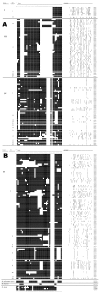Silent nucleotide polymorphisms and a phylogeny for Mycobacterium tuberculosis
- PMID: 15498158
- PMCID: PMC3320301
- DOI: 10.3201/eid1009.040046
Silent nucleotide polymorphisms and a phylogeny for Mycobacterium tuberculosis
Abstract
Much remains unknown of the phylogeny and evolution of Mycobacterium tuberculosis, an organism that kills 2 million people annually. Using a population-based approach that analyzes multiple loci around the chromosome, we demonstrate that neutral genetic variation in genes associated with antimicrobial drug resistance has sufficient variation to construct a robust phylogenetic tree for M. tuberculosis. The data describe a clonal population with a minimum of four distinct M. tuberculosis lineages, closely related to M. bovis. The lineages are strongly geographically associated. Nucleotide substitutions proven to cause drug resistance are distributed throughout the tree, whereas nonsynonymous base substitutions unrelated to drug resistance have a restricted distribution. The phylogenetic structure is concordant with all the previously described genotypic and phenotypic groupings of M. tuberculosis strains and provides a unifying framework for both epidemiologic and evolutionary analysis of M. tuberculosis populations.
Figures



References
-
- Drobniewski FA, Pablos-Mendez A, Raviglione MC. Semin Respir Crit Care Med. 1997;18:419–29. 10.1055/s-2007-1009357 - DOI
Publication types
MeSH terms
Substances
Grants and funding
LinkOut - more resources
Full Text Sources
Other Literature Sources
